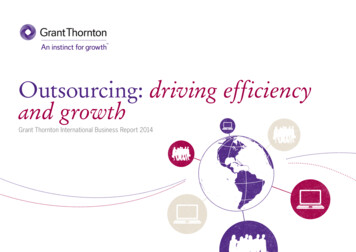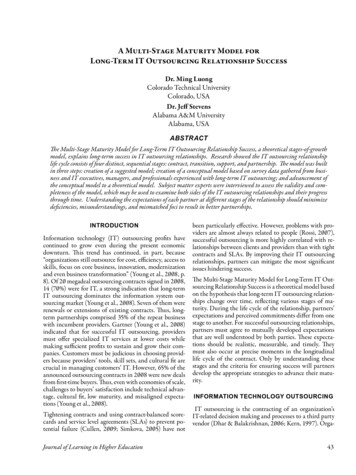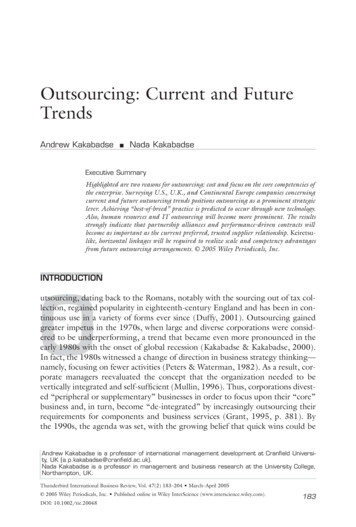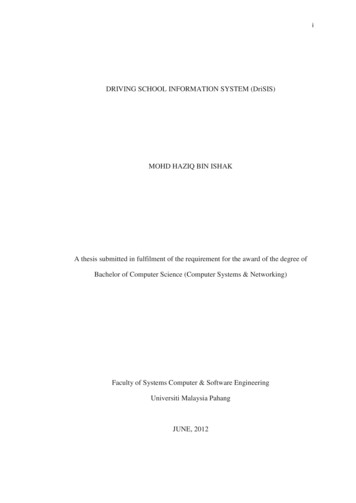
Transcription
Outsourcing: driving efficiencyand growthGrant Thornton International Business Report 2014
Outsourcing: driving efficiency and growthContents Introduction Outsourcing today Drivers Obstacles Encouraging outsourcingOutsourcing trendsThis report draws on 3,300 interviews with businessleaders in 45 economies to better understand businessattitudes to outsourcing: Why and what functions arebusinesses outsourcing? What is preventing businessesfrom outsourcing? And how can theseobstacles be overcome?Drivers to outsourceImproving efficienciesReducing costBetter access to expertiseEnsuring business continuity57%45%45%Business processes outsourced46%TaxIT44%32%27%Unwillingness tolose control of akey processThe high cost ofimplementationToo complex or risky tocontract out services55%40%global businesses whocurrently (or plan to)outsource businessprocesses49%Obstacles to Pacific36%HR &PayrollOutsourcing: driving efficiency and growth 2
Outsourcing: driving efficiency and growthIntroduction1006%firms offeroutsourcing servicespercentage ofglobal revenuesBusinesses have been outsourcing key processes to third parties formany years, but it was perhaps around the turn of the 21st centurythat the term ‘outsourcing’ started to gain traction. Around this time,businesses began to outsource to other countries – a process knownas ‘offshoring’ – with large emerging markets such as India offering16%significant cost savings through access to huge cohortsof cheap,tech-savvy, young people.The process of offshoring has drawnpolitical and public attention withconcerns raised that it was destroyingdomestic jobs. Some level of ‘reshoring’has since taken place, but the cost andefficiency drivers to outsource businessprocesses remain strong. Indeed,outsourcing services now account for closeto 6% of Grant Thornton global revenues,a figure which is climbing all the time.This report gives fresh insight intoattitudes towards outsourcing amongstmid-market businesses. It is a processwhich tends to be associated with majorcorporates but the survey shows thatdemand is strong amongst smaller peers:two in five currently (or plan to) outsourcebusiness processes, rising to half in LatinAmerica and close to two-thirds insouthern Europe. Around three-quartersof businesses globally would not consideroffshoring, but larger businesses (those11%with 250 employees) are more likely58%to consider both outsourcing andoffshoring. Tax,ITandHR-payrollare15%the most popular functions that businessleaders are currently outsourcing withimproving efficiencies and reducing costthe major drivers.The results also reveal that the majorityof mid-market business leaders show noinclination to outsource businessprocesses. Very few have had a poor pastexperience of outsourcing, rather they aremainly put off by an unwillingness to losecontrol of a key process and perceived highset-up costs. However, many businesseswould reconsider their position if theyneeded to cut costs, find efficiencies orsaw their workload increase significantly.Please contact your local Grant Thorntonoffice to discuss the outsourcing needs ofyour business.Outsourcing at Grant ThorntonPrincipal services16%26%Bookkeeping/accounting services (incl. tax)11%HR &45%Payroll26%58%45%15%Business process outsourcingOther11%6%11%6%6%6%6%6%35Principal firms303525302025Sweden 20BrazilFrance5Source: Grant ustraliaPoland0South Africa-5-10Q3-2012 Q4-2012 Q1-201Outsourcing: driving efficiency and growth 3Q3-2012 Q4-2012 Q1-2013 Q2-2013 Q3-2013 Q4-2013
Outsourcing: driving efficiency and growth“Businesses seeoutsourcing as an opportunityto increase efficiency andkeep headcount low with futuregrowth prospects still somewhatclouded by uncertainty of therecovery in Europe.”Outsourcing todayThe IBR results suggest that outsourcing is reasonably popular in the mid-market: 40% of businessleaders globally either currently or plan to outsource business processes, climbing to 43% of larger businesses,where economies of scale mean outsourcing can have a greater impact. This rises to 64% in southern Europewith businesses in Spain (70%) and Italy (62%) amongst the most likely to outsource. Outsourcing is alsoprevalent in Latin America (51%) – especially Argentina (64%) and Brazil (53%) – and Africa (Botswana68%; South Africa 48%). By contrast, just 26% of businesses in southeast Asia are keen on outsourcing withbusinesses in the Philippines (4%) and Vietnam (12%) amongst the least likely to be looking at it globally.Tax services (49%) are the most likely function to be outsourcedglobally, rising to 64% in North America and 58% in the G7and Latin America. 53% of larger businesses outsource taxservices (compared with 46% of smaller peers) and it is also themost outsourced function in Asia Pacific. This compares withjust 13% of those outsourcing tax services in the Nordics.IT services (46%) rank second globally; 52% of businessesin Europe currently (or plan to) outsource IT, driven by largeproportions in the Nordics (66%),eastern Europe (63%) andsouthern Europe (54%). HR-Payroll (36%) comes thirdglobally, driven by the 55% of North American businesses;40% of larger businesses outsource this function, comparedwith 33% of smaller competitors. A further 36% of businessesoutsource (or plan to outsource) other services which couldinclude financial planning and bookkeeping.However, mid-market business leaders are more warywhen it comes to outsourcing a back-office function toanother country. Offshoring is most popular in southernEurope where 13% are already doing it and another 21%say they would consider it. By contrast, 82% of businessesin Latin America and 80% of those in Asia Pacific wouldnot consider offshoring. Larger businesses (26%) are morelikely to consider offshoring than smaller peers (20%).Ignacio de SopeñaGrant Thornton SpainDo you currently (or have any plans) to outsource any business processes? (% al37%BRIC51%LatinAmericaSource: Grant Thornton IBR 201448%SouthAfrica42%AsiaPacificOutsourcing: driving efficiency and growth 4
Outsourcing: driving efficiency and growthDriversHow important are the following drivers in your decision to outsource back-office services?Globally, businesses which outsource are principally looking forefficiencies (57%) and to reduce costs (55%). With low-cost labourgenerally less prevalent in developed economies compared withdeveloping peers, it is notable that business leaders in North Americaand Europe are more likely to cite these drivers. In North America,70% cite reducing cost and 69% improving efficiencies; in Europethe proportions are 63% and 67% respectively.These drivers are also central to thedecisions to outsource of businesses indeveloping economies but they are alsodriven by a desire to allow staff to focus onthe core strategies, such as gaining marketshare. This emerges as the key outsourcingdriver in Asia Pacific (excl. Japan; 57%),Latin America (56%) and the BRICeconomies (51%).Business leaders in developing economiesalso see outsourcing as a way of accessingexpertise that might not necessarily be asreadily available locally; 46% of BRICbusinesses cite better access to expertise asan outsourcing driver, compared with 39%in the G7, and 45% cite mitigating riskthrough using specialists, versus 35%across the G7.There is some variation in theoutsourcing drivers for smaller and largerbusinesses. Larger businesses are morefocussed on reducing cost and improvingefficiencies (both 58%) while smallerbusinesses are more likely to be lookingto use outsourcing providers to ensurebusiness continuity (48%) – perhapsbecause departures are often more keenlyfelt in businesses with lower headcounts– free up staff to focus on core strategy(44%) and reduce headcount (37%).“Tapping into theskills and expertise offeredby outsourcing providers canhelp businesses focus ontheir core activities, boostingproductivity and results, providingthem with a competitive edge.”Madeleine BlankensteinGrant Thornton BrazilBRICGlobalG7Improving efficiencies495753Reducing cost505553Ensuring business continuity454538Better access to expertise464539Allowing staff to focus on core strategy514334Mitigating risk through using specialists454235Reducing staff headcount393532Ability to cut outsourced staff more easilythan employees333330Source: Grant Thornton IBR 2014Outsourcing: driving efficiency and growth 5
Outsourcing: driving efficiency and growthObstaclesAmong the three-fifths ofbusinesses with no plans tooutsource, the major obstacle is anunwillingness to lose control of akey process. This is cited by 44%of respondents (rising to 49% inlarger businesses) and emerges asthe chief impediment in everyregion except Latin America.Interestingly, this is more of anissue in developed markets with50% of those in the G7 citing thislack of control as an obstacle,compared with just 35% in theBRIC economies. This obstacle ishighest in North America (58%)and also elevated in Europe (47%).Costs are also perceived to be achallenge: 32% globally (and 34%in larger businesses) cite the high costof implementation as an obstacle tooutsourcing. This is a particular issue inthe developing economies of southeastAsia (53%) and Latin America (38%),but almost as high in Europe (36%)and in North America (33%). Just14% of business leaders are negativelyinfluenced by a bad past experienceof outsourcing, although this rises to28% in Latin America.In Asia Pacific, the lack of a strategicplan to outsource (28%) also rankshighly, suggesting the issue is not on theagenda in many boardrooms across theregion. Meanwhile, business leaders inEurope (29%) and North America (30%)are concerned that they would have tolay off staff if they moved back-officeprocesses out of house. This links backto the fact that businesses in developedeconomies are using outsourcingprincipally to cut costs. By contrast,peers in developing markets are more likelyto be looking to access additional expertise;in other words, augmenting rather thanreplacing existing people.“There is a popularmisconception thatoutsourcing a process meansa company loses control. In fact,outsourcing can actually helpleaders take a step back andgain a clearer picture of howthe business is performingagainst its strategy.”Samantha GeorgeGrant Thornton UKWhat are the major obstacles to your business in outsourcing?44%Unwillingness to losecontrol of a key process32%The high cost ofimplementation27%24%22%21%14%Too complex/riskyto contract servicesLaying offexisiting staffLack of suitableoutsourcing companiesLack of strategicplan to outsourceBad past experienceof outsourcingSource: Grant Thornton IBR 2014Outsourcing: driving efficiency and growth 6
Outsourcing: driving efficiency and growth“Leaders of highgrowth businesses canquickly find their inbox fillingup with administrative issues;outsourcing can help themmanage their workload andfocus on priorities.”Encouraging outsourcingThere are a range of factors that would encourage those businesses withno plans to outsource to consider it, but as with the drivers discussedearlier, a need to reduce costs or search for efficiencies are top of the list.Globally, 41% of business leaders cite arequirement to find cost savings, led by50% of those in North America, 48% inLatin America, 44% in southeast Asia and43% in Europe. The drive for processefficiencies – where the focus is on doingthings better and faster, rather than simplycheaper – is most evident in Latin America(50%) and southeast Asia (42%), but is alsoa major driver in North America (44%).Both finding cost savings (48%) andefficiencies (38%) are much bigger driversfor larger businesses.Around a third of business leaders saythey need more confidence in outsourcingproviders before they would considerhanding over key processes, suggestingproviders could do more to marketthemselves as reliable partners. This isparticularly true for larger firms: 43% citea need for more confidence in providers,compared with just 25% of smaller peers.This factor emerges as the second biggestdriver in North America (47%) and is alsohigh in Latin America (40%) and across theG7 (37%). Close to a third also say that anincrease in workload would make arounda third of businesses consider outsourcing,led by North America (43%), southeastAsia (37%) and the G7 (36%).In Europe, an aversion to outsourcing isevident at board level. Across the EU, 38%of business leaders say it would need achange in company policy for them toconsider outsourcing , rising to 43% in theeurozone. This also emerges as a big driverin Latin America (37%), but less so inNorth America (29%) and Asia Pacific(19%). By contrast, businesses in NorthAmerica are more likely to require achange in legislation (40%) comparedwith Europe (27%).Vinamra ShastriGrant Thornton IndiaWhat might encourage your business tooutsource back office services?41Requirement to find cost savings33Search for process efficienciesIncrease in workload32Improved confidence inoutsourcing providers32Information communicationstechnology improvementsChange in company policyChange in legislation292827Source: Grant Thornton IBR 2014Outsourcing: driving efficiency and growth 7
IBR 2014 methodologyThe Grant Thornton International Business Report (IBR) is the world’s leading mid-market business survey,interviewing approximately 3,300 senior executives every quarter in listed and privately-held businesses all over theworld. Launched in 1992 in nine European countries, the report now surveys more than 12,500 businesses leaders in 45economies on an annual basis, providing insights on the economic and commercial issues affecting companies globally.The data in this report are drawn from 3,300 interviews conducted in September 2013. Respondents were chiefexecutive officers, managing directors, chairmen and other senior decision-makers from all industry sectors inmid-market businesses based all over the world. The definition of mid-market varies between economies; in theUnited States it refers to businesses with US 10m-US 2bn in annual revenues; in the United Kingdom, those with100-499 employees.To find out more about IBR, please visit: www.internationalbusinessreport.com.Dominic KingGrant Thornton International LtdGlobal research managerT 44 (0)207 391 9537E dominic.king@gti.gt.com2013 Grant Thornton International Ltd. 2014‘Grant Thornton’ refers to the brand under which the Grant Thorntonmember firms provide assurance, tax and advisory services to theirclients and/or refers to one or more member firms, as the context requires.Grant Thornton International Ltd (GTIL) and the member firms are not aseparate legalworldwide partnership. GTIL and each member firm is a seperateentity. Services are delivered by the membermember firms. GTIL does not provideservices to clients. GTIL and its member firms are not agents of, and donot obligate, one another and are not liable for one another’s acts or omissions.www.gti.org
Outsourcing trends Outsourcing: driving efficiency and growth This report draws on 3,300 interviews with business . HR & Payroll Business process outsourcing Other. 43% North America 51% Latin America 64% Southern Europe 42% Asia Pacific 48% South Africa 36% EU 33% Nordic 31% Eastern Europe 26% UAE 26% Southeast Asia 42% G7 40%










